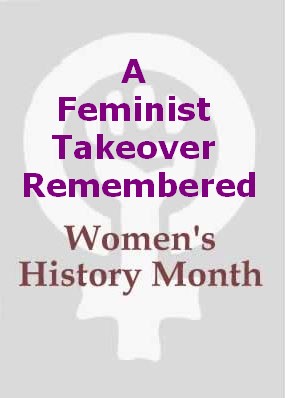|
|
|

|
|

|
|
|


"Boston was once an intellectual haven
with activist circles of feminism in its
heyday. Today it is mostly a forgotten
history, which is one of the reasons for
“Left on Pearl” documentary."
|
Most
days when the weather permits my morning constitutional is a two
mile walking loop around the Charles River. From my house I walk south
toward Memorial Drive via Western Avenue. At the intersection of
Western Avenue and Memorial Drive I turn right in the direction toward
Harvard Square. Exactly one block from the intersection is Hingham
Street and approximately fifteen feet from its curb stands one of the
many blue and white Cambridge Historical Commission plagues you see
throughout the city. This one reads the following:
"888
Memorial Drive. Site of a Harvard building occupied by feminists who
demanded affordable housing, child care and education, the and founded
the Cambridge Women’s Center, March 6-15, 1971.”
For years I’ve seen the sign, read it and wondered how the protest took
place. This past International Women’s Day at a special sneak preview
screening celebrating the completion of the documentary “Left on
Pearl,” and the 45th anniversary commemorating the takeover of 888
Memorial Drive I learned the story behind the plague.
“Left on Pearl: Women Take Over 888 Memorial Drive” helps us celebrate, remember and cheer one of our most vilified heroes of the last century — the women’s movement.
The film vibrantly brings to life -through a multiplicity of women
voices and across a spectrum of race, class, sexual orientation and
gender expressions - archival images of the social and political
context of the 60’s and 70’s, revealing the confluence of political
struggles of the time - Vietnam War, Black Civil Rights, Black Power,
and LGBT rights movements -which both informed and ignited the women’s
movement known as Second Wave Feminism.
Zooming in on the ten-day occupation of 888 Memorial Drive “Left on
Pearl,” a fifty-five minute documentary, narrates three interrelates
stories: the need for a women’s space, the denunciation of the
gentrification of the of the predominantly African American Riverside
community, and Harvard University’s land grab into working class
Cambridge communities.
888 Memorial Drive, a former knitting factory, was the Architectural
Technology Workshop, a Harvard-owned building used by the design
school. The building was slated for demolition to construct new
graduate school housing and it was chosen for its proximity to
Riverside. Today graduate housing stands there and the address is 10
Akron Street, a side street of formerly 888 Memorial Drive - and a good
distance from the commemorative plague.
“Left on Pearl” captures the high spirit, youthful exuberance,
revolutionary furor of the time. It documents the hilarity, excitement
and outright boldness (along with the scandalous moments) of the
movement. If you thought for one moment these women lacked chutzpah,
“Left on Pearl” quickly disabuses you of the notion.
For example, when Harvard turned the heat and electricity off in the
building, the women broke into the basement and turned the electricity
back on. And when a lone male representative of the Harvard Republican
Club for Equality and Economic, Political, and Social Opportunities for
Women came to criticized the women for their method of protest, the
women drowned him out.
And who said feminists aren’t any fun?
The women had lots of fun, holding dance parties, and self-defense
classes. And in defiance of the cult of domesticity and all of its
requisite accoutrements of their time nearly 100 women cut off their
hair.
Boston was once an intellectual haven with activist circles of feminism
in its heyday. Today it is mostly a forgotten history, which is one of
the reasons for “Left on Pearl” documentary.

In 1969 the first feminist conference was held at Emmanuel College
spawning Bread and Roses, the first socialist women’s organization in
the country, and one of the groups responsible for 888 Memorial Drive
building takeover.
In 1971 in Cambridge, Female Liberation began publishing “The Second Wave Magazine: A Magazine for the New Feminism.
And, the most important book published during the Second Wave Women’s
Movement, in my opinion, and also in the last century was “Our Bodies,
Ourselves” (originally called the Boston Women's Health Book
Collective).
Protest marches abound with women of color and poor women publicly
denouncing the political stronghold and exclusionary practices of the
movement - especially in it’ s early years, which had primarily been an
intentionally exclusive women's country clubs that spoke to Betty
Friedan's feminine mystique of upper-crust "pumps and pearls"-wearing
white women.
In 1974 the Combahee River Collective was founded in Boston by the
bodacious act of several lesbians and feminists women of African
descent. The Combahee River Collective was not only a response to the
Black Nationalist and misogynistic politics of the Black Power
Movement, but the Collective was also excoriating the exclusionary
practice of feminism.
Black women — straight or LBT — had neither voice nor visibility in
much of the movement, but not so in the 888 Memorial Drive building
takeover. Saundra Graham, an African American, former city councilwoman
and president of the Riverside Planning team had a pivotal role in
protesting Harvard’s expansion into her community with rising
rents. Good news is that Graham still resides in Riverside today
thanks to the efforts of the protest.
"Left on Pearl” correctly highlights sexual orientation and gender
identity issues as another fault line in the movement. One reason was
that in 1969, Betty Friedan, then president of the National
Organization for Women, called us “the Lavender Menace” stating that
LBT women were a huge liability to the women’s movement.
“Left on Pearl” tells the story of a little-known but very important
event in the social history of the Second Wave of the women’s movement.
On Sunday I took my spouse to see the plague commemorating the
takeover. Having both seen the film we joyously recalled and shared our
favorite moments. Before leaving the site I turned to Thea and
said “Those were some badass sisters, wouldn’t you say?” She
nodded in agreement as we continued on toward Harvard Square.
“Left on Pearl” is produced by the 888 Women’s History Project, whose
members are Libby Bouvier, Susan Jacoby and Rochelle Ruthchild,
executive producer. Susie Rivo is the director/filmmaker, and she and
Iftach Shavit did the editing. The videographer is Lynn Weissman.
I thank them all for their labor of love in helping us to remember.
|
BlackCommentator.com Editorial Board member and Columnist, The Rev. Irene Monroe, is a religion columnist, theologian, and public speaker. She is the Coordinator of the African-American Roundtable of the Center for Lesbian and Gay Studies in Religion and Ministry (CLGS) at the Pacific School of Religion. A
native of Brooklyn, Rev. Monroe is a graduate from Wellesley College
and Union Theological Seminary at Columbia University, and served as a
pastor at an African-American church before coming to Harvard Divinity
School for her doctorate as a Ford Fellow. She was recently named to
MSNBC’s list of 10 Black Women You Should Know. Reverend Monroe is the author of Let Your Light Shine Like a Rainbow Always: Meditations on Bible Prayers for Not’So’Everyday Moments. As an African-American feminist theologian, she speaks for a sector of society that is frequently invisible. Her website is irenemonroe.com. Contact the Rev. Monroe and BC.
|
 |
|
|
|
|
 |
|
|
|
 is published every Thursday is published every Thursday |
Executive Editor:
David A. Love, JD |
Managing Editor:
Nancy Littlefield, MBA |
Publisher:
Peter Gamble |
|
|
|
|
|
|
|
|
|
|
|
 |
|
|
|
|
|
|

